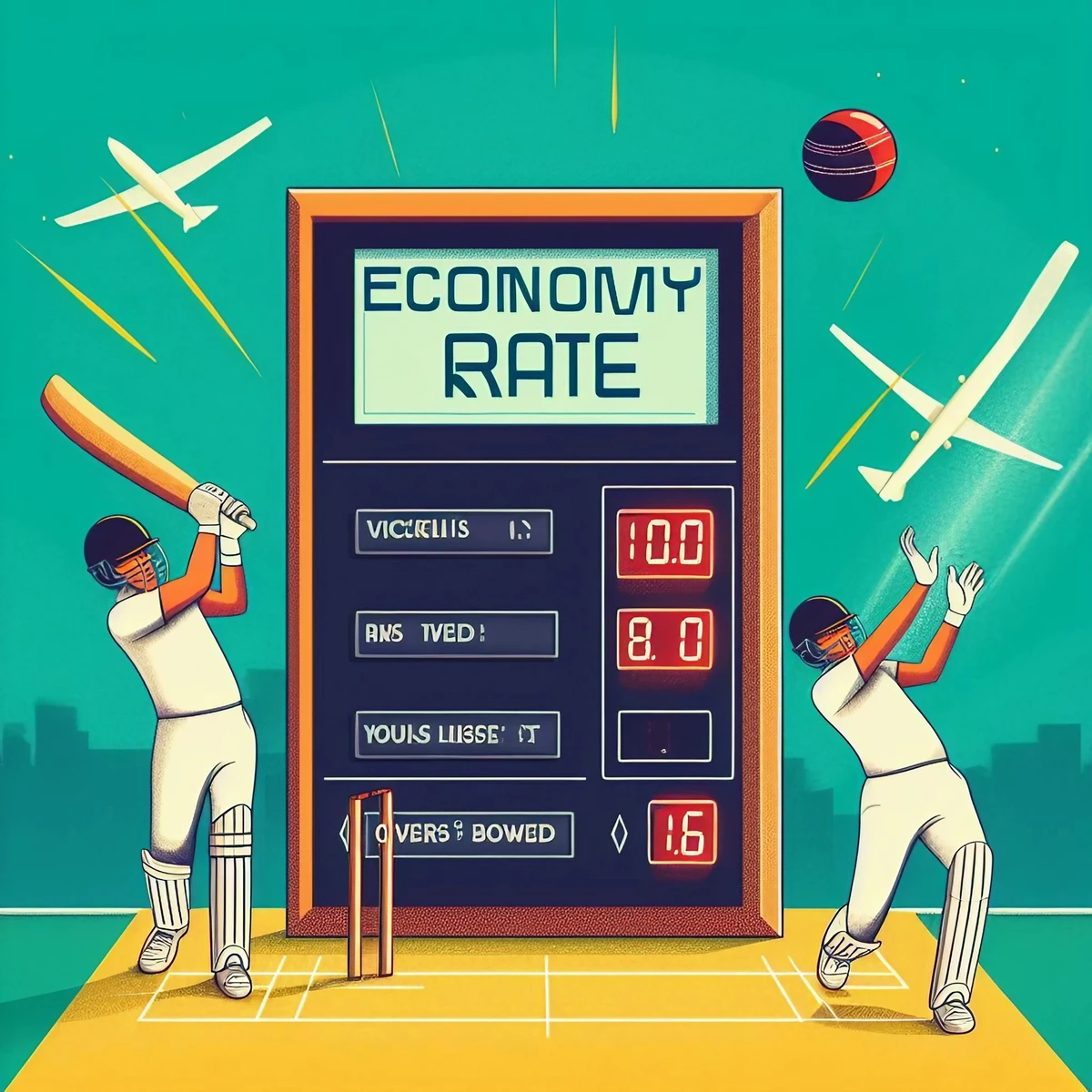Home » Cricket Calculators » Net Run Rate Calculator: How to Calculate Run Rate in Cricket
How Net Run Rate is Calculated
Net Run Rate Calculator: How to Calculate Run Rate in Cricket
Run rate reveals the tempo of a team’s scoring in cricket. It is calculated by simply dividing total runs by overs faced.
200% Spribe Aviator Welcome Bonus
200% Spribe Aviator Welcome Bonus
- Fastest Indian Rupees Withdrawals
- Fast deposits with UPI
- Available in four different Indian languages
In cricket, run rate is a crucial metric that provides valuable insights into a team’s scoring rate. It is calculated by dividing the total runs scored by a team by the number of overs bowled.
Net Run Rate Calculator
How to Calculate Run Rate in Cricket: Formula & Examples – Run rate in cricket measures a team’s scoring tempo in terms of runs per over.
It is an insightful statistic for assessing batting performance and progress in limited overs matches.
The run rate formula simply divides total runs scored by total overs faced. For example, if a team scores 300 runs in 50 overs, their run rate is 300/50 = 6 runs per over.
A higher run rate indicates a team is scoring quickly and putting pressure on the opponent. Run rate also determines par totals for teams batting first based on common benchmarks.
TL;DR
Hide- Run Rate, also known as Runs Per Over (RPO), indicates the number of runs scored by the batting team in an over.
- Net Run Rate is obtained by subtracting the average runs per over scored by a specific team from the average runs per over scored against that team during the competition.
- Net Run Rate is used to determine the ranking of teams in tournaments.
- Full Run Rate provides an average measure of a team’s scoring rate throughout the entire match or tournament.
During run chases, calculating the run rate required helps evaluate a team’s likelihood of reaching the target. Comparing current and required run rates gives crucial context on match situations.
With knowledge of how to calculate and interpret run rates, fans can better evaluate batting efforts, progress trends and match dynamics. It is an essential metric for gauging ODI and T20 performances.
The Basics of Run Rate Calculation

Run rate reveals the tempo of a team’s scoring in cricket. It is calculated by simply dividing total runs by overs faced.
Variables like batting lineup, pitch conditions and bowling attacks influence run rate fluctuations. Aggressive batting, rotating strike and capitalizing on loose balls can boost scoring rates.
Building partnerships, maintaining high run rates during powerplays and targeting weaker bowlers are key strategies to up the run rate.
Teams analyze required run rates during chases to gauge feasibility of reaching targets. Comparing current and required rates provides match context.
Whether assessing past innings or live situations, run rate gives crucial insights into scoring speeds. It is a fundamental statistic for gauging ODI and T20 batting performances.
Understanding the Formula for Run Rate
To understand the net run rate formula in cricket, it is important to consider the ratio of total runs scored by a team to the number of overs bowled. The formula for calculating run rate accurately is:
Run Rate = Total Runs Scored / Total Overs Bowled
Factors affecting run rate in cricket include:
- Batting performance: The ability of the batsmen to score runs quickly affects the run rate.
- Bowling quality: The skill of the bowlers in restricting the opposition’s scoring rate impacts the run rate.
- Pitch conditions: The nature of the pitch can either favor the batsmen or the bowlers, influencing the run rate.
By analyzing these factors and using the net run rate formula, cricket teams can determine their run rate and assess their batting performance in a match or tournament.
Understanding the formula for run rate is crucial for teams to strategize and adjust their gameplay accordingly.
Step-by-Step Guide to Calculate Run Rate
Calculation of run rate in cricket involves determining the ratio of total runs scored by a team to the number of overs bowled. This calculation provides an insight into the team’s scoring rate and helps in assessing their performance.
The run rate is calculated differently in different formats of the game. In limited-overs matches, such as One Day Internationals and T20s, the run rate is calculated by dividing the total runs scored by the number of overs bowled.
In Test matches, the run rate is calculated by dividing the total runs scored by the number of overs played.
The run rate has a significant impact on team strategy as it helps teams assess their scoring rate and set targets for their opponents. It also influences the decision-making process during a match, such as when to accelerate the scoring or when to play cautiously.
Net Run Rate Calculation: Examples of Run Rate Calculation in Cricket
Examples of Run Rate Calculation in Cricket can provide a practical understanding of how this important statistic is determined in different formats of the game.
Here are some examples:
- Example 1: In a One Day International (ODI) match, Team A scores 250 runs in 50 overs. The run rate can be calculated by dividing the total runs scored (250) by the number of overs bowled (50), resulting in a run rate of 5 runs per over.
- Example 2: In a Twenty20 (T20) match, Team B scores 180 runs in 20 overs. The run rate can be calculated by dividing the total runs scored (180) by the number of overs bowled (20), resulting in a run rate of 9 runs per over.
- Example 3: In a Test match, Team C scores 400 runs in 100 overs. The run rate can be calculated by dividing the total runs scored (400) by the number of overs bowled (100), resulting in a run rate of 4 runs per over.
The run rate has a significant impact on match strategy, as teams need to maintain a required run rate to win or chase a target.
It helps teams assess the pace of their batting performance and make informed decisions about their approach to scoring runs.
Importance of Run Rate in Assessing Scoring Rate
Run rate plays a crucial role in evaluating the scoring rate of a team in cricket, providing valuable insights into their performance. It is not just a statistic, but also a measure of a team’s ability to score runs consistently and at a good pace.
Run rate is particularly important in limited-overs matches, where teams have a fixed number of overs to score as many runs as possible. In such matches, maintaining a high run rate is essential to build a competitive total or chase down a target.
- Net Run Rate Calculator: How to Calculate Run Rate in Cricket
- Cricket Batting Average Calculator
- Cricket Batting Strike Rate Calculator
- Cricket Bowling Average Calculator
- Cricket Bowling Strike Rate Calculator
- Cricket Economy Rate (Econ) Calculator
- Cricket Follow On Calculator
- Cricket Runs per Over Calculator
Additionally, run rate is used to determine the rankings of teams in a tournament, as it reflects their overall performance in terms of scoring runs.
It also has a direct impact on team strategy, as teams need to adjust their approach based on the required run rate or the run rate they need to maintain to stay ahead of their opponents.
Net Run Rate Calculation and Its Significance
Net Run Rate calculation is an important aspect in cricket that provides a comprehensive measure of a team’s performance in terms of scoring and conceding runs.
It is a key factor in determining the ranking of teams in tournaments and reflects a team’s overall performance. The significance of Net Run Rate can be understood through the following points:
- Fair representation: Net Run Rate takes into account both the runs scored and conceded by a team, providing a fair representation of their performance.
- Tie-breaker: In situations where teams have the same number of points in a tournament, Net Run Rate becomes crucial in determining the team’s position.
- Scoring ability: A higher Net Run Rate indicates a team’s ability to score runs at a faster pace, showcasing their batting prowess.
Net Run Rate calculation holds immense significance in cricket as it helps in assessing a team’s performance and determining their position in tournaments.
It provides a holistic view of a team’s scoring and conceding abilities, making it an essential metric in the sport.
Calculation of Net Run Rate in IPL
The calculation method for determining the Net Run Rate in the Indian Premier League (IPL) involves subtracting the average runs per over scored by a team from the average runs per over conceded by the same team.
This calculation provides a measure of a team’s overall performance in terms of scoring and conceding runs. Net Run Rate is an important factor in determining the position of teams in the IPL points table and can have a significant impact on team rankings.
To understand how Net Run Rate is calculated in the IPL, consider the following table:
| Team | Average Runs Per Over Scored | Average Runs Per Over Conceded |
|---|---|---|
| A | 7.5 | 8.2 |
| B | 8.1 | 7.8 |
| C | 7.9 | 7.5 |
| D | 8.5 | 8.7 |
| E | 7.3 | 7.0 |
Exploring the Concept of Full Run Rate
Full Run Rate is a comprehensive measure of a team’s overall scoring rate throughout a match or tournament. It provides an average measure of a team’s scoring rate throughout the entire duration of the game.
The Full Run Rate is influenced by several factors, such as the batting performance of the team, the number of overs played, and the total runs scored.
Advantages of a high run rate include:
- It reflects a team’s aggressive and dominant batting approach.
- A high run rate puts pressure on the opposition and can demoralize their bowlers.
- It allows a team to set challenging targets for the opposition.
Factors influencing the Full Run Rate include:
- The quality of the opposition’s bowling attack.
- The batting conditions and pitch characteristics.
- The batting order and the performance of individual batsmen.
A high Full Run Rate indicates a team’s ability to score runs consistently and at a fast pace, which can be advantageous in a match or tournament.
Notable Records of Highest Run Rates in Cricket
One notable record in cricket is the highest run rate achieved in a single match or tournament.
In One Day International (ODI) cricket, the highest run rate ever recorded was during a match between England and Australia in 2018.
England scored a staggering 481 runs in their allotted 50 overs at a run rate of 9.62. This extraordinary run rate showcased England’s aggressive batting approach and their ability to score at a rapid pace.
The impact of a high run rate on team strategies is significant. A high run rate puts pressure on the opposition, forcing them to adopt defensive tactics and potentially make mistakes. It also allows teams to set challenging targets or chase down large totals with confidence.
Applications of Run Rate in Cricket Tournaments
Applications of Run Rate in Cricket Tournaments include assessing the competitiveness and performance of teams throughout the course of the tournament.
The advantages of run rate in cricket are:
- Provides a quick and easy way to compare the scoring rates of different teams.
- Helps in determining the required run rate for the chasing team in limited-overs matches.
- Allows for the calculation of net run rate, which is used to determine the ranking of teams in tournaments.
However, there are limitations to the run rate calculation. It does not take into account the quality of opposition, the impact of wickets lost, or the match situation.
Additionally, run rate can fluctuate significantly during a match, making it less reliable for assessing a team’s overall performance.
Despite these limitations, run rate remains a valuable tool in cricket tournaments, providing a snapshot of a team’s scoring rate and aiding in the evaluation of their competitiveness.
Concluding Thoughts: Net Run Rate Calculator & Formula
In conclusion, understanding and calculating run rate in cricket is essential for assessing a team’s scoring ability and determining their position in a tournament.
By dividing the total runs scored by the number of overs bowled, run rate provides insights into a team’s momentum and pace in their batting performance.
Additionally, net run rate takes into account the average runs per over scored and conceded by a team, providing a measure of their overall performance.
These metrics play a crucial role in evaluating team rankings and determining the required run rate for the chasing team in limited-overs matches.
Frequently Asked Questions
What Is the Highest Run Rate Ever Recorded in a Cricket Match?
The highest run rate ever recorded in a cricket match was 13.9 runs per over, achieved by Afghanistan in a T20 International. This exceptional scoring rate reflects their ability to score runs at a rapid pace.
How Does the Net Run Rate Calculation Differ From the Regular Run Rate Calculation?
The net run rate calculation differs from the regular run rate calculation in cricket by incorporating the average runs per over scored against a team. It provides a more comprehensive measure of a team’s performance and is used to determine rankings and tie-breakers.
Can the Run Rate Be Negative?
The run rate in cricket cannot be negative as it represents the scoring rate of a team. However, adverse weather conditions can impact the run rate by reducing the number of overs played. Strategies to improve run rate include aggressive batting and quick scoring.
Does the Run Rate Calculation Take Into Account Extras and Penalty Runs?
The run rate calculation in cricket does not take into account extras and penalty runs. The impact of extras on the run rate and the importance of penalty runs in the calculation are not considered in the formula.
Up to 75% Reload Bonus on Aviator
Up to 75% Reload Bonus on Aviator
- UPI, Paytm, gPay & PhonePe withdrawals
- Fast deposits with UPI
- Available in four different Indian languages
How Does the Full Run Rate Differ From the Run Rate Calculated per Over?
The full run rate differs from the run rate calculated per over as it provides an average measure of a team’s scoring rate throughout the entire match or tournament, while the run rate per over focuses on a specific period. The full run rate is used to compare the scoring abilities of different teams and has an impact on team strategy.
Other Cricket Calculators
Latest Cricket Posts
Claim 200% Welcome Bonus
For a limited time, every new member can claim 200% Welcome Bonus upon registration up to ₹15,000. Read to bet?














